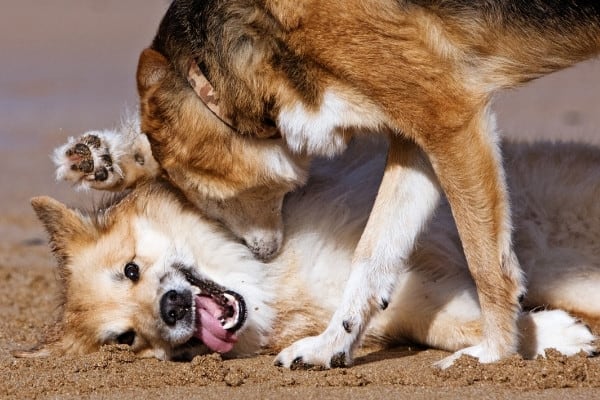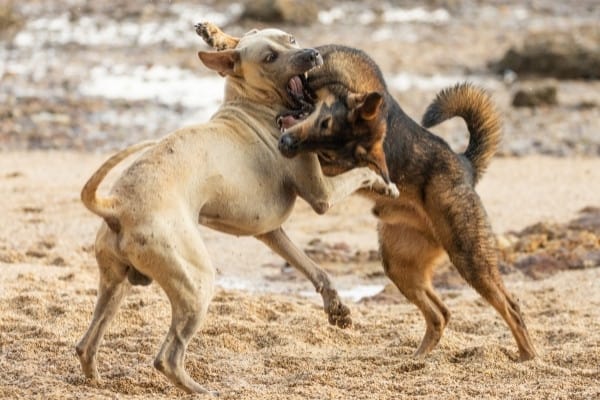
It’s common to see dogs chasing, wrestling, and even mouthing one another. But why do dogs bite each other on the neck?
When dogs bite each other on the neck, it commands attention and might make you wonder whether they’re playing or trying to hurt each other.
Why do dogs bite each other’s necks? Dogs often bite each other’s necks during normal play. Playful neck biting teaches bite inhibition and strong social skills. However, neck biting can also be aggressive in nature. This can be dangerous if allowed to continue. Watch for deep growling, one-sided “play,” and lack of bite inhibition.
Sometimes neck biting can be aggressive. If you recognize the early signs of aggression in dogs, you can prevent an injury before it happens.
Here, you will learn the differences between playful and aggressive neck biting, what to watch for, and when to intervene.
Neck Biting in Dogs
Most dogs participate in neck biting. While it might be alarming to watch, it’s typical for dogs to socialize this way.
Their body language can help you figure out whether they’re being aggressive or just having fun.
Neck Biting as Normal Behavior During Play
Playful neck biting is perfectly normal. It serves an important purpose early on and continues to be a common way for dogs to interact. It teaches them boundaries, control, and good manners in a social setting.
Neck biting is fine as long as they follow the four rules of healthy play: meta-signals, activity shifts, role-reversal, and self-handicapping (M.A.R.S).
Meta-signals: These are actions that communicate information to other dogs. They convey that a dog’s actions are playful, not aggressive.
Activity shifts: Dogs should do a variety of activities while they play and use meta-signals to show that an activity is about to change and that it’s still playful.
Role-reversal: Taking turns as dominant and submissive is important for fair play. Dogs don’t have to split roles evenly as long as they communicate and take turns to a degree.
Self-handicapping: Dogs inhibit their abilities, such as bite force, to be fair and prevent other dogs from getting hurt.
How To Identify Playful Neck Biting
You can identify playful neck biting by how the dogs respond to each other.
If both dogs are taking part in the activity and their behavior appears to be in sync, they’re probably having a great time.
When dogs are engaged in play, it sometimes looks and sounds a lot more vicious than it actually is.
When your dog’s chest is close to the ground and his backside is sticking up in the air, he’s play bowing.
According to a study on play bows, dogs are most likely to bow immediately before or after doing something that their playmate could perceive as aggressive.
If a dog bows before or after biting another dog’s neck, they’re just having fun.
Neck Biting as Sign of Aggression
If your dog’s neck biting becomes aggressive, address it as soon as possible. Several underlying triggers may cause it:
Fear: Fear often leads to aggression. They feel vulnerable, so they compensate for that vulnerability with aggressive behavior.
Overwhelming excitement: Excitement can shift and become aggressive, turning what started as a playful neck bite into something not nice.
Feeling territorial: Dogs can become extremely territorial or possessive of their people, their toys, or their space. If they feel like another dog is trying to take over what’s theirs, the reaction may be intense.
High prey drive: Certain breeds have an innate drive to hunt other animals. When dogs simulate a relationship between predator and prey, it can trigger a more authentic response.
Pain: If a dog is in pain while playing, he might lash out in response to the pain.
How To Identify Aggressive Neck Biting
When a dog’s neck biting becomes aggressive, the other dog will probably try to escape the situation. You might notice the interaction become one-sided with no role reversal.
Since an aggressive dog will not exercise bite inhibition, the dog being bitten might yelp or cry out.
An aggressive dog might try to make more of an impact by shaking the other dog by the neck.
This is extremely dangerous and could quickly cause injury or even death, especially if one dog is a lot bigger than the other.
How To Tell Whether a Dog Is Being Aggressive or Playing

Dogs’ body language can tell you a lot about how they feel and what you can expect from them.
Traits of a dog who’s just playing around include:
- Light, bouncy movements.
- Big goofy grin.
- High-pitched growling.
- Full-body wiggle.
- Lots of play bows.
When a dog is being aggressive, an outburst rarely comes out of nowhere. There are several clues in a dog’s body language that might convey aggression.
Traits of a dog who’s becoming aggressive include:
- Stiff body.
- Raised hackles.
- Pinned-back ears.
- Visible teeth.
- Low growl.
- Intense stare.
- High, twitching tail.
When To Intervene
Intervene when you spot early signs that a dog might become aggressive.
If a dog obsesses over a toy, gets possessive of his owner, or isn’t picking up on meta-signals, separate them for the time being to avoid a conflict.
Playtime should only continue if both dogs are enjoying themselves. If you’re unsure whether both dogs are having fun, do a simple consent test to find out.
Remove your dog from the situation by telling him to come to you. If both dogs are eager to get back to playing, then they consent.
If at least one dog walks away, shows interest in something else, or hides, playtime is over. Do a consent test as often as you want.
How Neck Biting Relates to Bite Inhibition
Dogs use their mouths for many things, and they need to know how much bite force is acceptable in each situation.
Bite inhibition refers to a dog’s ability to control the force of his bite. It’s a crucial skill for puppies, and neck biting helps them develop this skill.
A puppy who’s accidentally bitten too hard on the neck will probably yelp and stop playing. Next time, the puppy who did the biting won’t bite as hard.
The sharp yelp and the consequences of biting too hard teach them to inhibit their bite.
How To Stop Aggressive Neck Biting
Resist the urge to scold a dog for neck biting too aggressively. It might inspire more aggression by making him feel less secure. Insecurity often triggers an aggressive response.
Instead, remove your dog from the situation and make an appointment with the vet. Ask your vet to run some tests to make sure physical pain isn’t triggering his aggression.
If the problem is behavioral, ask for a consultation with a behavior specialist.
Related Questions:
Why Do Dogs Bite Each Other on the Face?
When dogs bite each other on the face, they’re probably playing one of the most common dog games there is, called “bitey face.”
To play, each dog tries to bite the other dog’s face. When a couple of socialized dogs play bitey face, it’s a low-risk game, which is much more gentle and friendly than it looks.
Why Do Dogs Bite Each Other’s Legs?
When a dog bites another dog’s legs, it’s usually just a normal part of how they play.
Herding dogs, like Border Collies, tend to nip at other dogs’ legs more than other breeds because it’s part of their herding instinct. Prey drive may also play a part.
How can you tell if dogs are playing or fighting?
Use the consent test we’ve outlined above, and keep an eye on your dogs! If the playtime gets too rough, separate your dogs to allow them to calm down a bit!
Conclusion for “Why Do Dogs Bite Each Other on the Neck?”
While it’s normal for dogs to bite each other’s necks while they’re playing, there are times it isn’t so playful.
Always watch your dog’s body language while he’s playing with other dogs to find out if they’re having fun.
If your dog’s neck biting is aggressive, don’t scold him. Get to the root of the problem and consult a professional.
Sources:
https://www.akc.org/expert-advice/training/are-they-playing-or-fighting/
https://inrelationwithdogs.com/2020/04/27/is-it-all-just-play-games/
https://resources.bestfriends.org/article/dog-bites-how-manage-dog-willing-bite
https://www.dogstardaily.com/blogs/games-dogs-play
https://pethelpful.com/dogs/How-to-Tell-if-Dogs-are-Playing-or-Fighting




